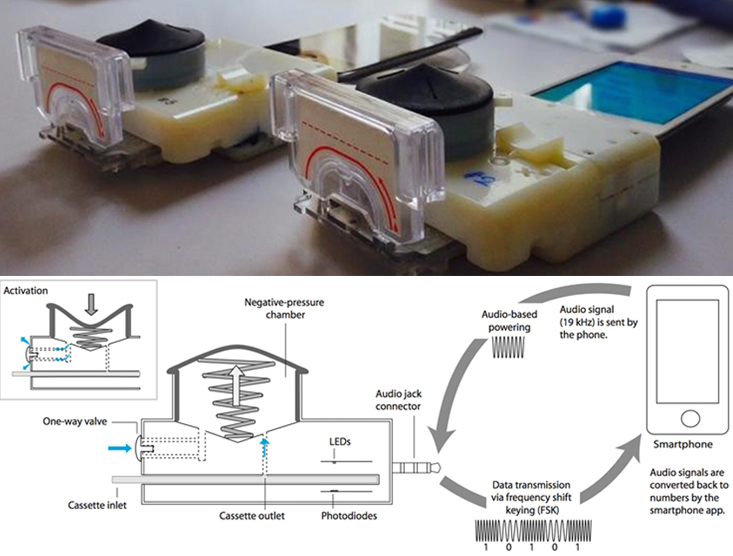HiJack Enables a Smartphone Dongle for Diagnosis of Infectious Diseases
HiJack is a hardware/software platform that utilizes the headset jack on a smartphone as a universal power/data interface.

 Enlarge
Enlarge
Imagine the good that could come from a handheld, networked computer with the ability to provide medical diagnostic support, environmental monitoring, remote control, and other functions. Such a system would utilize a variety of small and inexpensive sensor peripherals to become an EKG monitor, a glucose monitor, a CO sensor, a soil moisture monitor, or a motion sensor, taking the place of larger, more expensive systems and making it useful for fieldwork or to provide service and care in underdeveloped regions.
That computer is your smartphone, and the interface to those sensors is HiJack, a hardware/software platform that utilizes the headset jack on a smartphone as a universal power/data interface. HiJack was developed by Prof. Prabal Dutta and his students five years ago and continues to enable new technology across the world that will benefit the greater good.
When designing HiJack, the researchers chose to use the headset port because it was the only interface that was open, simple, and inexpensive. Their goal was to understand the design space, enable phone-powered peripherals, and make the phone the center of a new instrumentation ecosystem for developing regions, and that is exactly what they accomplished.
After developing and demonstrating the utility of HiJack, Prof. Dutta open-sourced the plans to the interface with hopes that it would become adopted and utilized to develop the series of sensors they envisioned. In 2011, a kit was made available through Seeed Studio. In 2012, Energy Micro (now SiLabs) released an application note showing how HiJack could run on their EFM32 microcontrollers. And, in 2014, NXP introduced a development platform based on HiJack called Quick-Jack.
HiJack has opened the door to new low cost phone-centric sensing applications. It is now possible to plug a cubic inch sensor into almost any smartphone, power the device, read its output back, process the data, and present or transmit a result. The hardware can be produced for as low as $2.34 without having to deal with licensing issues.
Recently, a team of researchers from Columbia University developed an HIV and syphilis point of care test that detects the diseases within 15 minutes after a fingerprick of blood. The smartphone dongle draws all the necessary power from the phone to perform a triplex test to detect the HIV antibody, treponemalspecific antibody for syphilis, and nontreponemal antibody for active syphilis infection.
The dongle was used by Rwandan health care workers at prevention of mother-to-child transmission clinics or voluntary counseling and testing centers. It was discovered that 97% of patients preferred to use the dongle compared to the laboratory tests because the results were quick and it only involved a single fingerprick.
In Science Daily, Samuel Sia, one of the researchers who developed the dongle stated, “Our work shows that a full laboratory-quality immunoassay can be run on a smartphone accessory, coupling microfluidics with recent advances in consumer electronics can make certain lab-based diagnostics accessible to almost any population with access to smartphones. This kind of capability can transform how health care services are delivered around the world.”
The researchers hope to increase testing and reduce the number of deaths from both diseases.
HiJack has enabled this smartphone dongle as well as many other accessories and it will surely aid other researchers in the future.
Related Links
Science Daily: HIV and syphilis biomarkers: Smartphone, finger prick, 15 minute diagnosis
NXP press release: NXP Unveils Smartphone Quick-Jack Solution Transforming Audio Jack into Multi-Purpose, Self-Powered Data Port
U-M project page: Project HiJack
Technical paper (pdf): Hijacking Power and Bandwidth from the Mobile Phone’s Audio Interface


 MENU
MENU